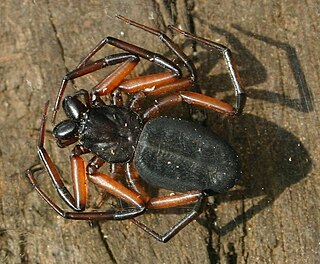
The spider family Liphistiidae, recognized by Tamerlan Thorell in 1869, comprises 8 genera and about 100 species of medium-sized spiders from Southeast Asia, China, and Japan. They are among the most basal living spiders, belonging to the suborder Mesothelae. In Japan, the Kimura spider is well known.

A rai stone, or fei stone is one of many large artifacts that were manufactured and treasured by the native inhabitants of the Yap islands in Micronesia. They are also known as Yapese stone money or similar names.

Hexathelidae is a family of mygalomorph spiders. It is one of a number of families and genera of spiders known as funnel-web spiders. In 2018, the family was substantially reduced in size by genera being moved to three separate families: Atracidae, Macrothelidae and Porrhothelidae. Atracidae includes the most venomous species formerly placed in Hexathelidae.

Cytaea is a genus of spiders in the family Salticidae.
Xenocytaea is a genus of spiders in the family Salticidae (jumping spiders).
Cytaea carolinensis is a species of jumping spiders.
Cytaea koronivia is a species of jumping spiders.
Cytaea nausori is a species of jumping spiders.
Cytaea ponapensis is a species of jumping spider.
Cytaea vitiensis is a species of jumping spider.
Sobasina yapensis is a species of jumping spider.
Cytaea levii is a species of jumping spider.

Psechridae is a family of araneomorph spiders with about 70 species in two genera. These are among the biggest cribellate spiders with body lengths up to 2 centimetres (0.79 in) and funnel webs more than 1 metre in diameter.

Barychelidae, also known as brushed trapdoor spiders, is a spider family with about 300 species in 42 genera. Most spiders in this family build trapdoor burrows. For example, the 20 millimetres (0.79 in) long Sipalolasma builds its burrow in rotted wood, with a hinged trapdoor at each end. The 10 millimetres (0.39 in) long Idioctis builds its burrow approximately 5 centimetres (2.0 in) deep, just below the high tide level, sealing the opening with a thin trapdoor.

Trochanteriidae is a family of spiders first described by Ferdinand Karsch in 1879 containing about 180 species in 21 genera. Most are endemic to Australia though Doliomalus and Trochanteria are from South America and Olin and Plator are from Asia. Platyoides species exist in southern and eastern Africa, Madagascar, and the Canary Islands with one species, P. walteri, introduced to Australia.

Mysmenidae is a spider family with about 135 described species in thirteen genera. The family is one of the least well known of the orb-weaving spiders because of their small size and cryptic behaviour. These spiders are found in humid habitats such as among leaf litter and in caves.

Euophryini is a tribe of jumping spiders. It has also been treated as the subfamily Euophryinae.

Cyrtophora moluccensis is a tent-web spider in the orb-weaver family. It is commonly known as the tent spider or dome-web spider, and is native to India, Japan, Indonesia, Papua New Guinea, Australia, Fiji, and Tonga. It is often found in disturbed or open habitats from coasts to forest and mountainous interiors.
Michael I. Saaristo was a Finnish arachnologist, with a particular interest in the spiders of the Seychelles. The World Spider Catalog lists 61 genus names or synonyms and 109 species names or synonyms of which he is the sole or co-author.
Cytaea taveuniensis is a jumping spider species in the genus Cytaea. The male was first identified in 2010 by Barbara Maria Patoleta and Joanna Gardzińska. The female has not been described.









